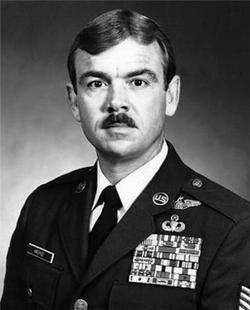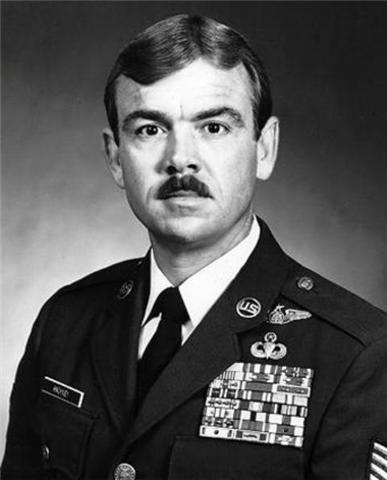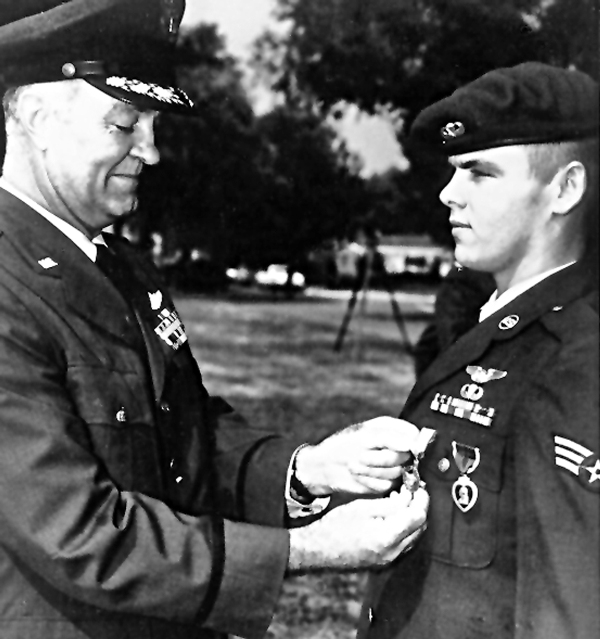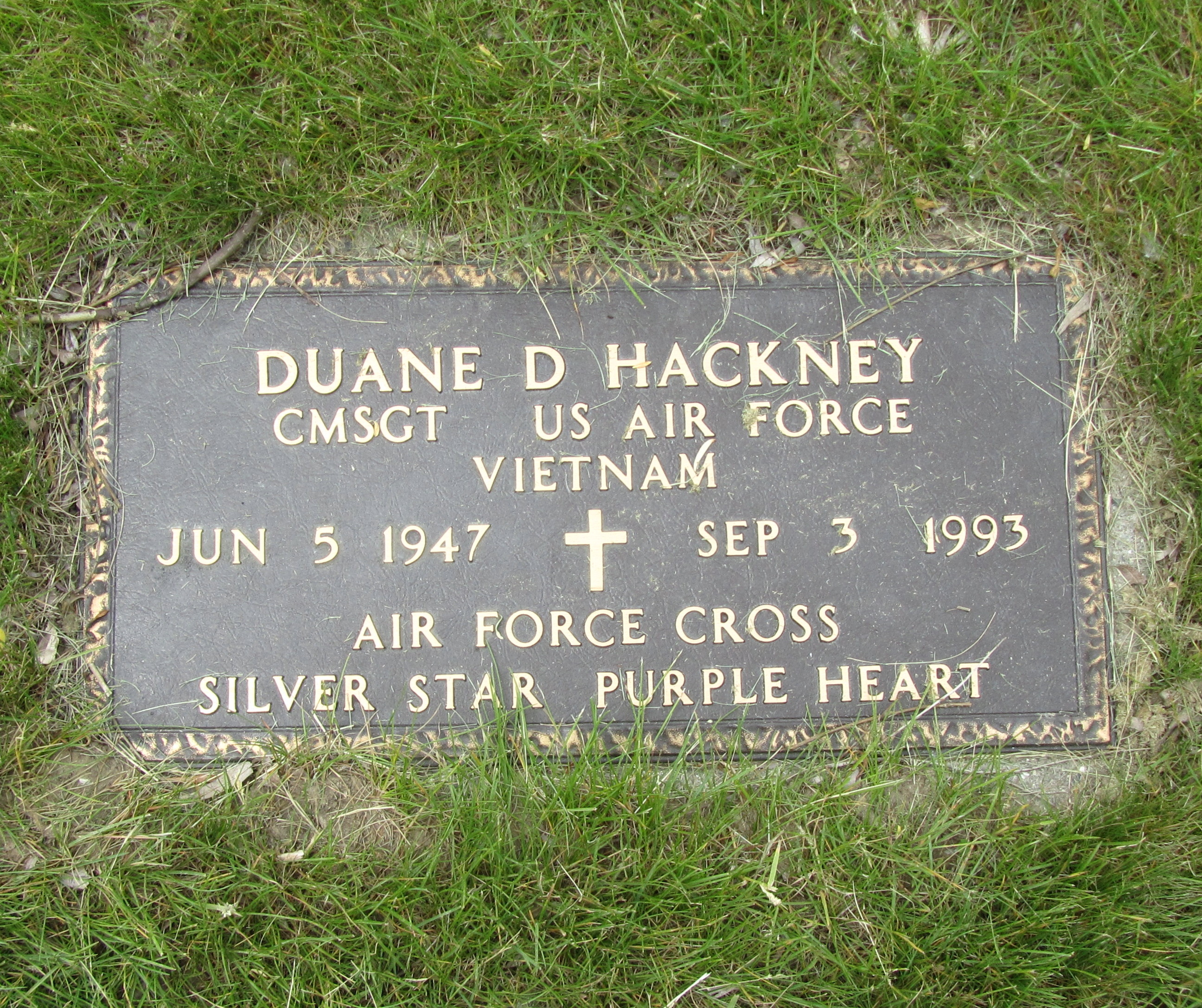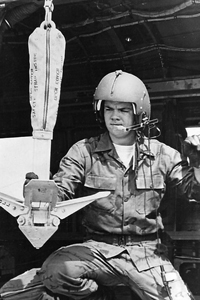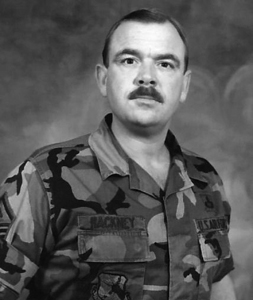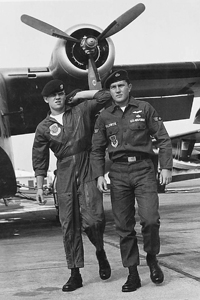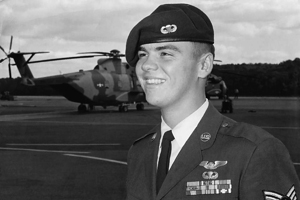Three days after reporting for duty, Hackney flew his first combat mission. Somewhere on that mission, a .30-caliber slug buried itself in his leg. To avoid being grounded by the medics, he had one of his PJ friends remove the slug with a probe. That incident set the tone for the more than 200 combat missions he was to fly in three and a half years of Vietnam duty, all as a volunteer.
Five times in the months ahead his helicopter was shot down. He doesn't recall how often he went down into the jungle looking for survivors or how many lives his medical training helped him save. As he became a legend in the rescue world, he earned four Distinguished Flying Crosses, not for flying a certain number of missions but for specific acts of heroism, and 18 Air Medals, many for single acts of valor. Then came the Air Force Cross, for which he was the first living recipient, the Silver Star, the Airman's Medal, the Purple Heart, and several foreign decorations.
Hackney's most celebrated mission was on February 6, 1967, when two HH-3 helicopters, Jolly Green 05 and Jolly Green 36, launched from the 37th ARRS at Da Nang Air Base, Republic of Vietnam. They were attempting the recovery of a downed O-1F pilot, Nail 65, northwest of Dong Hoi, North Vietnam. After Airman Hackney made one unsuccessful trip to the ground in search of the pilot, both Jollys returned to base due to foul weather. Later in the day, the helicopters launched again and located the survivor. Airman Hackney was lowered to the ground, and after securing the survivor into the Stokes litter, both were lifted out. No sooner did they reach Jolly 05's door when ground fire erupted. As they raced to exit the area, the helicopter was hit with a 37 mm anti-aircraft round and caught fire. With complete disregard for his own welfare, Airman Hackney removed his parachute and placed it on the survivor. He lunged to grab another one from storage as the helicopter, a growing, blazing fireball, arched across the sky. In an instant, it exploded, just as Airman Hackney slipped his arms through the harness. He was blown out of Jolly 05 by the explosion. Dangling from the harness, he was able to manage to pull the ripcord, and the chute opened just as he hit the trees, where he plunged a further 80 feet and came to rest on a ledge in a crevasse. He narrowly avoided capture while enemy troops jumped across the crevasse, mere feet above. Jolly 36 immediately made a run in to locate any survivors, and, when it arrived, found only burning wreckage...and Duane Hackney waving his arms for pickup. He was the only survivor.
Airman Hackney went on to receive more than 70 individual awards becoming the most decorated enlisted man in Air Force history. Upon his return from Vietnam in 1967, Hackney was deployed to the 41st Aerospace Rescue & Recovery Squadron (41st ARRS) at Hamilton Air Force Base, in Marin County, California. Shortly after the awarding of his Air Force Cross on September 9, 1967, Hackney made a guest appearance on The Ed Sullivan Show. In 1991 he retired as a Chief Master Sergeant. Duane D. Hackney died of a heart attack on September 3, 1993. He was 46 years old.
Three days after reporting for duty, Hackney flew his first combat mission. Somewhere on that mission, a .30-caliber slug buried itself in his leg. To avoid being grounded by the medics, he had one of his PJ friends remove the slug with a probe. That incident set the tone for the more than 200 combat missions he was to fly in three and a half years of Vietnam duty, all as a volunteer.
Five times in the months ahead his helicopter was shot down. He doesn't recall how often he went down into the jungle looking for survivors or how many lives his medical training helped him save. As he became a legend in the rescue world, he earned four Distinguished Flying Crosses, not for flying a certain number of missions but for specific acts of heroism, and 18 Air Medals, many for single acts of valor. Then came the Air Force Cross, for which he was the first living recipient, the Silver Star, the Airman's Medal, the Purple Heart, and several foreign decorations.
Hackney's most celebrated mission was on February 6, 1967, when two HH-3 helicopters, Jolly Green 05 and Jolly Green 36, launched from the 37th ARRS at Da Nang Air Base, Republic of Vietnam. They were attempting the recovery of a downed O-1F pilot, Nail 65, northwest of Dong Hoi, North Vietnam. After Airman Hackney made one unsuccessful trip to the ground in search of the pilot, both Jollys returned to base due to foul weather. Later in the day, the helicopters launched again and located the survivor. Airman Hackney was lowered to the ground, and after securing the survivor into the Stokes litter, both were lifted out. No sooner did they reach Jolly 05's door when ground fire erupted. As they raced to exit the area, the helicopter was hit with a 37 mm anti-aircraft round and caught fire. With complete disregard for his own welfare, Airman Hackney removed his parachute and placed it on the survivor. He lunged to grab another one from storage as the helicopter, a growing, blazing fireball, arched across the sky. In an instant, it exploded, just as Airman Hackney slipped his arms through the harness. He was blown out of Jolly 05 by the explosion. Dangling from the harness, he was able to manage to pull the ripcord, and the chute opened just as he hit the trees, where he plunged a further 80 feet and came to rest on a ledge in a crevasse. He narrowly avoided capture while enemy troops jumped across the crevasse, mere feet above. Jolly 36 immediately made a run in to locate any survivors, and, when it arrived, found only burning wreckage...and Duane Hackney waving his arms for pickup. He was the only survivor.
Airman Hackney went on to receive more than 70 individual awards becoming the most decorated enlisted man in Air Force history. Upon his return from Vietnam in 1967, Hackney was deployed to the 41st Aerospace Rescue & Recovery Squadron (41st ARRS) at Hamilton Air Force Base, in Marin County, California. Shortly after the awarding of his Air Force Cross on September 9, 1967, Hackney made a guest appearance on The Ed Sullivan Show. In 1991 he retired as a Chief Master Sergeant. Duane D. Hackney died of a heart attack on September 3, 1993. He was 46 years old.
